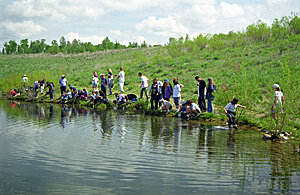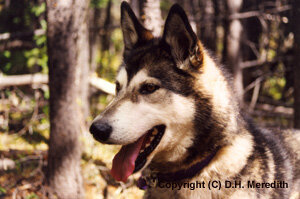Archived Publications
For many years I wrote a column for the Alberta Outdoorsmen magazine (now Alberta Outdoors) on outdoor ethics and issues. Many of the pieces listed below are from that column. I present the pieces here as representations of the kind of writing I do.
Note: the works available on this web site are protected by copyright. Please respect a writer's right to earn a living.
I know I'm a dying breed. It's evident every time I go to a designated campsite in a national or provincial park. There, I'm only provided a gravel pad on which to break my stakes and wear out the floor of my tent.
It seems a simple enough concept — as a hunter, you should give your quarry a fair chance to escape being taken. In other words, no excessive measures should be used to entrap or otherwise reduce a game animal's chance of detecting and escaping you. Talk to a room full of hunters and chances are they will all agree with such a general statement. After all, "fair chase" is touted as an important element of hunting ethics and a key to continued public acceptance of hunting. Yet, talk to that same room of hunters about how fair chase is applied to specific types of hunting, and chances are you'll get considerable disagreement.
While writing last month's column on wounding and loss, I found myself taking off on a tangent to discuss personal ethics, or how we make the moral decisions we do in the field.
If there had been any doubt that we were in true wilderness, it was dismissed when guide Dave O'Farrell placed his 12 gauge shotgun in his boat. "Did you bring your bear spray, Don?”
Plummer’s Great Slave Lake Lodge is one of the oldest lodges in the North. Great Slave Lake itself is the ninth largest lake in the world (28,500 sq. km; 11,000 sq. mi.), and the deepest in North America (614 m; 2014 ft.). It is ice free maybe four months of the year and the water is cold at all times. Under such conditions, fish grow slowly; and under low fishing pressure, they grow very large over a long life.
Although I had been in northern Alberta several times as a biologist and angler, I had not been in northern Saskatchewan, where this incredible northern landscape is in stark contrast to the stereotypical Saskatchewan image of prairie wheat fields. So, when I was contacted by Tourism Saskatchewan to be part of a group of American and Canadian outdoor writers touring some of the many fishing lodges in northern Saskatchewan, I jumped at the opportunity.
Crossing lake ice can be nerve racking if you let your imagination get the best of you — even when you're crossing a lake with ice ten or more feet in thickness. That's what I was doing many years ago on the Boothia Peninsula in the Canadian High Arctic. My Inuk assistant, David Nanook, and I were following fresh caribou tracks across the lake.
I've fished my share of "honey holes" in my life. You know, places where the fishing is so red-hot that the retelling of their stories makes them legends in our lives. The earliest such legend I can remember was when I was about six-years-old.
It is an issue that is raised every year on Internet bulletin boards, letters to the editor and phone calls to government: "Why can't I hunt on Sunday in my favorite hunting area?" "Why in the 21st century are we still following 19th century religious laws in this province.”
A few years ago, a friend of mine who studies socio-economics—or the how and why people do the things they do—invited 20 or so moose hunters to meet with his team of researchers and discuss what it means to hunt moose.
It seems a simple enough concept — as a hunter, you should give your quarry a fair chance to escape being taken. In other words, no excessive measures should be used to entrap or otherwise reduce a game animal's chance of detecting and escaping you. Talk to a room full of hunters and chances are they will all agree with such a general statement. After all, "fair chase" is touted as an important element of hunting ethics and a key to continued public acceptance of hunting. Yet, talk to that same room of hunters about how fair chase is applied to specific types of hunting, and chances are you'll get considerable disagreement.
Fall is in the air, and my den is strewn with camping equipment in various stages of readiness. Why? The moose rut is about to begin.
The question is sometimes asked when I'm making a presentation about wildlife or the outdoors to school classes, youth groups, or even adults. I've told a story about a hunting experience or how wildlife agencies use hunting as a management tool. I notice some surprised looks and head shaking in the audience, and then a brave soul finally asks, "Why do you hunt?”
The question is sometimes asked when I'm making a presentation about wildlife or the outdoors to school classes, youth groups, or even adults. I've told a story about a hunting experience or how wildlife agencies use hunting as a management tool. I notice some surprised looks and head shaking in the audience, and then a brave soul finally asks, "Why do you hunt?”
The question is sometimes asked when I'm making a presentation about wildlife or the outdoors to school classes, youth groups, or even adults. I've told a story about a hunting experience or how wildlife agencies use hunting as a management tool. I notice some surprised looks and head shaking in the audience, and then a brave soul finally asks, "Why do you hunt?”
We've all experienced it — that sudden rush of blood as the pulse quickens in anticipation of a coming hunt. We can't help it, whether we're a youth just starting out, or an old pro who's seen it all. It's something built into our physiology that probably dates back to when one of our ancestors first picked up a rock to get something different on the menu.
As I arrived at the top, I saw the object of the birds’ and coyote’s interest. It was the separated hind leg of a deer hooked up in a barbed wire fence. Much of the meat on the leg had been eaten. There were many fresh tracks around the leg and a drag trail behind it.
When I was a boy living in a suburb of Los Angeles, my friends and I would often take a trip on our bicycles to a local flood-control reservoir. The reservoir rarely had any significant water in it, just a small, meandering, tree-lined creek that ran intermittently. However, there usually were small ponds and pools where we could catch crawdads (crayfish), frogs and salamanders. Sometimes I would bring these animals home, and I had the good fortune to have parents who allowed me to keep them for a while, as long as I looked after them.
It seems when faced with overwhelming amounts of information, people tend to pick and choose their sources and ignore much information that might be relevant to the decisions they make.
I lost a friend recently. Actually, "lost" is not the right term. It is a euphemism for the fact that this friend died. However, to be truthful, she wasn't lost as much as we "put her down"—another euphemism for something we don't like to contemplate or talk about. You see, my friend was our family's Malamute-cross husky, Magic, who lived to the ripe old age of 15 or more years.
The news article appeared on one of my e-mail newsgathering services, and I read it with interest as I do all bear stories. However, this one was especially disturbing because Treadwell and Huguenard had been killed and partially eaten by one or more grizzly bears in their camp on the Alaska peninsula.
I regret having to write this column. You see, I live near Wabamun Lake—not close enough to be directly affected by the recent environmental disaster that occurred there, but close enough to feel the pain of the lake.
Crossing lake ice can be nerve racking if you let your imagination get the best of you — even when you're crossing a lake with ice ten or more feet in thickness. That's what I was doing many years ago on the Boothia Peninsula in the Canadian High Arctic. My Inuk assistant, David Nanook, and I were following fresh caribou tracks across the lake.
My huskies seldom bark. When they do it is for a good reason. Now the big, black-and-white male was sitting on his haunches, barking at an aspen tree branch that hung down into the dog pen.




















